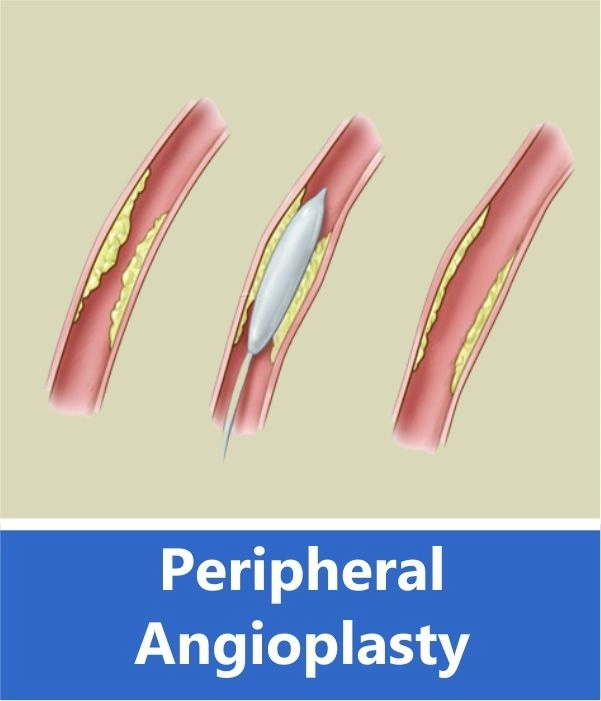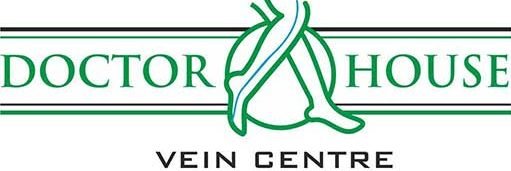

Peripheral Angioplasty
Peripheral Artery Disease
It is a major problem afflicting millions of people in the world. Caused by restricted blood flow to the peripheral arteries, which are situated in the arms, legs, and feet, Peripheral Artery Disease occurs when fatty deposits block blood flow to the feet. The decreased blood flow causes pain and circulation problems that progress and get worse, increasing the risk of stroke, heart attack, and amputation. Peripheral Angioplasty is used to reopen the blocked and narrowed peripheral arteries to restore proper blood circulation. Being a minimally-invasive surgery, the procedure is quite popular for Peripheral Artery Disease.
Most common causes include: Diabetes, cigarette smoking, high blood pressure, and high levels of blood cholesterol. PAOD commonly occurs in the arteries of the lower limbs.
In the lower limbs, narrowing of the arteries initially leads to pain and cramps in the thighs or calves on walking or climbing stairs. This pain disappears on resting. This type of pain is called ‘intermittent claudication’. Gradually, as the narrowing of the artery gets more severe, the distance in which the person can walk without pain decreases. In severe cases, there will be pain even at rest, usually more at night.
With critical narrowing in the blood vessels, there will be loss of hair over the foot and changes in the nails and skin color. Following an injury, healing may proceed very slowly, leading to the formation of an ulcer. Gangrene soon sets in, with discoloration of the limb, and finally, the limb may need to be amputated. Intermittent claudication is common with advancing age and occurs in about 5% of men and 2.5% of women above the age of 50 years. In about half the patients, the condition will remain stable for many years. One out of four patients, however, will deteriorate, and some will require amputation, especially diabetics and smokers
The simplest method of finding out, is the presence of a weak pulse in the affected artery. A special ultrasound test of the arteries (arterial color Doppler test) confirms the diagnosis. The final diagnosis is by performing a special Angiogram called digital subtraction angiography.
Almost any artery of the body which is narrowed or blocked can be opened. The arteries most commonly affected are those of the legs, kidneys, and the brain. Blockages of the arteries of the brain may give rise to episodes of weakness in the face and limbs, and later on to paralysis. In fact, opening up of these vessels (Carotid artery angioplasty) is one of the latest techniques used in preventing paralysis in a significant number of patients.
To prevent gangrene and amputation of the limbs, prompt diagnosis and treatment of the arterial narrowing is required. One must strongly consider angiography and angioplasty when :
1) Claudication distance gradually decreases – when the patient finds that he can walk smaller distances before stopping due to pain.
2) Presence of pain and discomfort at rest.
3) Changes in skin colour of the limb.
4) Limb starts to become cold as compared to the opposite one.
5) Early changes of gangrene. 6) Diabetic foot not responding to usual treatment.
It is now possible to treat patients with severe narrowings of the blood vessels with special “interventional techniques”. Under local anesthesia, a small needle is inserted into a leg artery. A thin wire is passed and threaded across the narrowed portion of the artery. A tiny balloon is then positioned and inflated across the narrowing, thereby compressing and flattening the cholesterol blockage. This reopens the artery, and blood flow resumes. This technique is called balloon angioplasty and is similar to what is used in opening the vessels of the heart.
This technique can also be safely performed in elderly, frail people, and patients with severe heart, lung and kidney disease. Balloon angioplasty procedures have a very high success rate. Over a period of time, however, a few of the arteries which have been opened with balloon angioplasty do tend to re-narrow. In general, the larger the blood vessel, the less the chance of re-narrowing occurring. In those cases where the physician suspects a high rate of re-narrowing, “stent implantation” is carried out. Stents are special metallic springs which are introduced within the artery. They act as struts to prop open a blood vessel. Stents are introduced through the same needle hole in the artery and do not require any surgical procedure.
After stent placement, the chance of re narrowing of the artery is very low, and the results rival that of major surgery. Sometimes, the artery is blocked due to a blood clot (thrombus). In such cases, a special plastic tube (catheter) is placed within the artery, at the site of the clot. Through this catheter drugs such as streptokinase, urokinase and Reopro are injected which help to dissolve the blood clot. Following injection of these drugs, additional balloon angioplasty and stenting may be necessary to compress any cholesterol blockages underlying the blood clot in the artery.
Interventional treatment of PAOD is done under local anesthesia, and usually, the procedure lasts from half-hour to two hours. Furthermore, most patients can be discharged from the hospital within 24 to 48 hours and can go walking home. There are no cuts, incisions or sutures, so the chances of infection are negligible (especially important in diabetic patients).
Furthermore, most patients who have significant PAOD also have narrowings of the blood vessels of the heart and would be at high risk of surgical operation. In surgery, the blockage is bypassed using a special synthetic graft. Most surgeries are major operations under full general anesthesia, and patients are required to stay in the hospital for at least 7 to 10 days. In addition, the mortality and morbidity rate of surgical procedures is many times that of interventional techniques.
Needless to say, all over the world, interventional techniques for the treatment of PAOD are the procedure of choice. However, there are some cases in which these techniques may not work. In such cases surgical intervention would be required.
